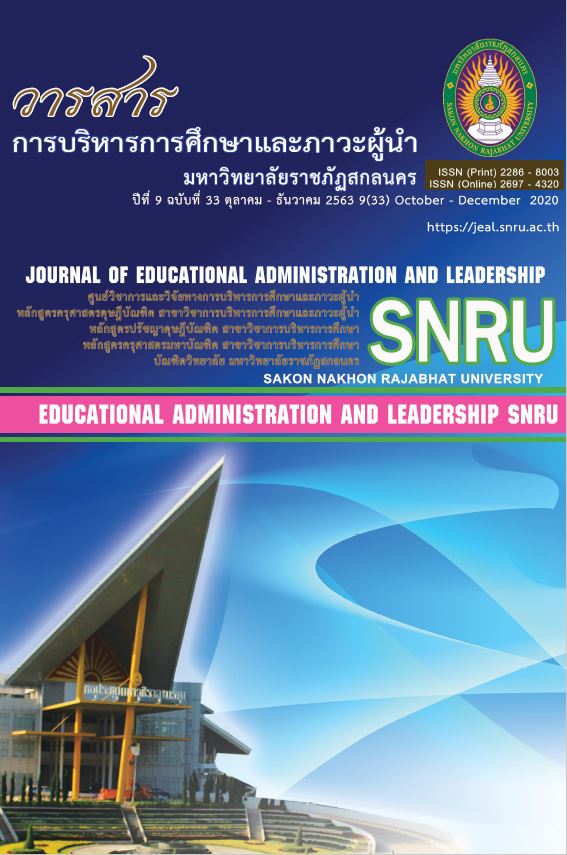

ประสิทธิผลการบริหารสถานศึกษาพอเพียง ในสังกัดสำนักงานเขตพื้นที่การศึกษา มัธยมศึกษา เขต 22
Administrative Effectiveness of Sufficient Educational Institutions under the Secondary Educational Service Area Office 22
ผู้แต่ง
มัลลิกา สีดาเดช, ธวัชชัย ไพใหล, วิจิตรา วงศ์อนุสิทธิ์
Author
Manlika Seedadech, Thawatchai Pailai, Vijittra Vonganusith
บทคัดย่อ
การวิจัยในครั้งนี้มีความมุ่งหมายเพื่อ 1) ศึกษาประสิทธิผลการบริหารสถานศึกษาพอเพียง 2) เพื่อเปรียบเทียบประสิทธิผลการบริหารสถานศึกษาพอเพียงตามความคิดผู้บริหารสถานศึกษาและครูผู้สอน จำแนกตามสถานภาพ ขนาดของสถานศึกษา ประสบการณ์ในการทำงาน และจังหวัดที่ตั้งของสถานศึกษา 3) เพื่อหาแนวทางยกระดับประสิทธิผลการบริหารสถานศึกษาพอเพียง กลุ่มตัวอย่างที่ใช้ในการวิจัย ได้แก่ ผู้บริหารสถานศึกษาและครูผู้สอน ในสังกัดสำนักงานเขตพื้นที่การศึกษามัธยมศึกษา เขต 22 ปีการศึกษา 2562 จำนวน 369 คน โดยใช้วิธีการสุ่มแบบหลายขั้นตอน (Multi-Stage Sampling) จำแนกเป็นผู้บริหารสถานศึกษา จำนวน 55 คน และครูผู้สอน จำนวน 314 คน เครื่องมือที่ใช้ในการเก็บรวบรวมเป็นแบบสอบถามชนิดมาตราส่วนประมาณค่ามีค่าความเชื่อมั่น 0.98 และแบบสัมภาษณ์ผู้เชี่ยวชาญเพื่อหาแนวทางยกระดับประสิทธิผลการบริหารสถานศึกษาพอเพียง สถิติที่ใช้ในการวิจัยในครั้งนี้ ได้แก่ ค่าเฉลี่ย ส่วนเบี่ยงเบนมาตรฐาน ทดสอบสมมติฐานโดยใช้การวิเคราะห์ข้อมูล t-test, One-Way ANOVA
ผลการวิจัย พบว่า
1. ประสิทธิผลการบริหารสถานศึกษาพอเพียง ในสังกัดสำนักงานเขตพื้นที่การศึกษามัธยมศึกษา เขต 22 ตามความคิดเห็นของผู้บริหารสถานศึกษา และครูผู้สอน โดยรวมและรายด้านอยู่ในระดับมาก
2. ประสิทธิผลการบริหารสถานศึกษาพอเพียงในสังกัดสำนักงานเขตพื้นที่การศึกษามัธยมศึกษา เขต 22 ตามความคิดเห็นของผู้บริหารสถานศึกษา และครูผู้สอน โดยรวม มีความคิดเห็นแตกต่างกันอย่างมีนัยสำคัญทางสถิติที่ระดับ .01
3. ประสิทธิผลการบริหารสถานศึกษาพอเพียงในสังกัดสำนักงานเขตพื้นที่การศึกษามัธยมศึกษา เขต 22 ตามความคิดเห็นของผู้บริหารสถานศึกษา และครูผู้สอน จำแนกตามขนาดของสถานศึกษา โดยรวม มีความคิดเห็นแตกต่างกันอย่างมีนัยสำคัญ ทางสถิติที่ระดับ .01
4. ประสิทธิผลการบริหารสถานศึกษาพอเพียงในสังกัดสำนักงานเขตพื้นที่การศึกษามัธยมศึกษา เขต 22 ตามความคิดเห็นของผู้บริหารสถานศึกษา และครูผู้สอน จำแนกตามประสบการณ์ในการทำงาน โดยรวม ไม่แตกต่างกัน
5. ประสิทธิผลการบริหารสถานศึกษาพอเพียงในสังกัดสำนักงานเขตพื้นที่การศึกษามัธยมศึกษา เขต 22 ตามความคิดเห็นของผู้บริหารสถานศึกษา และครูผู้สอน จำแนกตามจังหวัดที่ตั้งของสถานศึกษาโดยรวม ไม่แตกต่างกัน
6. แนวทางยกระดับประสิทธิผลการบริหารสถานศึกษาพอเพียง ในสังกัดสำนักงานเขตพื้นที่การศึกษามัธยมศึกษา เขต 22 ประกอบด้วย 3 ด้าน คือ 1) ด้านการบริหารจัดการสถานศึกษา ผู้บริหารสถานศึกษาน้อมนำหลักปรัชญาของเศรษฐกิจพอเพียงมากำหนดเป็นวิสัยทัศน์ของสถานศึกษา มีกระบวนการทำงานเพื่อพัฒนาคุณภาพและบริหารจัดการทรัพยากรที่มีอยู่ให้เกิดประโยชน์สูงสุด 2) ด้านหลักสูตรและการจัดการเรียนการสอน จัดทำหลักสูตรบูรการกับทุกกลุ่มสาระการเรียนรู้ให้สอดคล้องกับหลักปรัชญาของเศรษฐกิจพอเพียง โดยเน้นการจัดกิจกรรมเชิงสร้างสรรค์ (Active Learning) เพื่อกระตุ้นให้ผู้เรียนเกิดการเรียนรู้ด้วยตนเอง เกิดทักษะในการใช้ชีวิต รู้จักแก้ปัญหา และ 3) ด้านการพัฒนาบุคลากร ส่งเสริมให้บุคลากรในสถานศึกษาพัฒนาตนเองอย่างต่อเนื่อง พัฒนาความรู้ ความสามารถ ทักษะ จนสามารถพัฒนาศักยภาพของตนได้อย่างเต็มที่
Abstract
The purposes of this research aimed to 1) examine administrative effectiveness of sufficient educational institutions; 2) compare administrative effectiveness of sufficient educational institutions as perceived by school administrators and teachers, classified by status, school sizes, work experiences and provincial location; and 3) establish the guidelines for upgrading the administrative effectiveness of sufficient educational institutions. The samples, obtained through multi-stage sampling, were 55 school administrators and 314 teachers, yielding a total of 369 participants from schools under the Secondary Educational Service Area Office 22 (SESAO 22) in the academic year 2019. The research instruments for data collection included a rating scale questionnaire with the reliability of 0.98, and interview forms concerning administrative effectiveness of sufficient educational institutions. The statistics for data analysis were percentage, mean, standard deviation, t-test and One-Way ANOVA.
The findings were as follows:
1. The administrative effectiveness of sufficient educational institutions under the SESAO 22, as perceived by participants as a whole and each aspect was at a high level.
2. The administrative effectiveness of sufficient educational institutions under the SESAO 22, as perceived by participants as a whole showed a statistically significances at .01 level.
3. The administrative effectiveness of sufficient educational institutions under the SESAO 22, as perceived by participants from different school sizes, as a whole showed a statistically significances at .01 level.
4. The administrative effectiveness of sufficient educational institutions under the SESAO 22, as perceived by participants with different work experiences, as a whole was not different.
5. The administrative effectiveness of sufficient educational institutions under the SESAO 22, as perceived by participants from different provincial location, as a whole was not different.
6. The guidelines for upgrading administrative effectiveness of sufficient educational institutions under the SESAO 22 covered three aspects: 1) School Management. School administrators should integrate the principles of sufficiency economy philosophy into school visions and establish working processes for developing quality and existing resources management to achieve optimal usage; 2) Curriculum and Instructional Management. The guideline includes the establishment of an integrated curriculum within all learning areas in line with the principles of sufficiency economy philosophy into schools. In classroom practice, creative activities (Active Learning) should be a school focus to encourage learners to learn by themselves, provide life and problem solving skills; and 3) Personnel Development. School administrators should support personnel in educational institutions in their continuous self-development, knowledge development, abilities, and skills to reach their fully potential
คำสำคัญ
ประสิทธิผลการบริหารสถานศึกษาพอเพียง ปรัชญาของเศรษฐกิจพอเพียงKeyword
Administrative Effectiveness of Sufficient Educational Institutions, Sufficiency Economy PhilosophyNotice: Undefined variable: dataSet in /var/www/html/ArticleView.php on line 116
Notice: Trying to access array offset on value of type null in /var/www/html/ArticleView.php on line 116
บทความทุกบทความเป็นลิขสิทธิ์ของ
Notice: Undefined variable: dataSet in /var/www/html/ArticleView.php on line 116
Notice: Trying to access array offset on value of type null in /var/www/html/ArticleView.php on line 116
เท่านั้น
กำลังออนไลน์: 29
วันนี้: 0
เมื่อวานนี้: 1,423
จำนวนครั้งการเข้าชม: 1,172,793
อาคารบัณฑิตวิทยาลัย ชั้น 2 ตำบลธาตุเชิงชุม อำเภอเมือง จังหวัดสกลนคร 47000
โทร/
แฟกซ์ 0-4297-0093
บรรณาธิการ: รองศาสตราจารย์ ดร.ไชยา ภาวะบุตร
ติดต่อ/สอบถาม: นายธีรเวทย์ เพียรธัญญกรณ์
โทร: 0-4297-0093